Lingjing Kong
Step-Aware Policy Optimization for Reasoning in Diffusion Large Language Models
Oct 02, 2025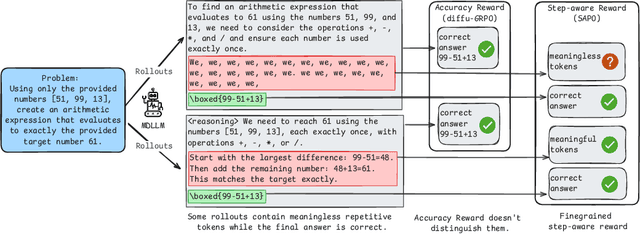

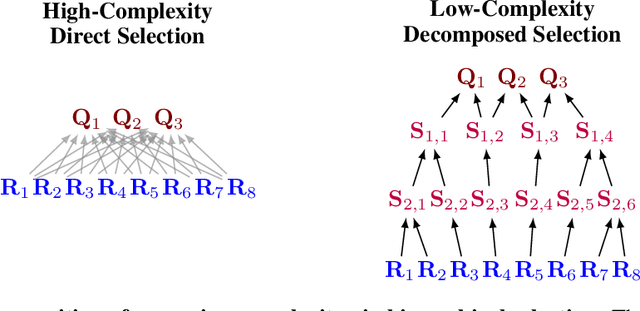
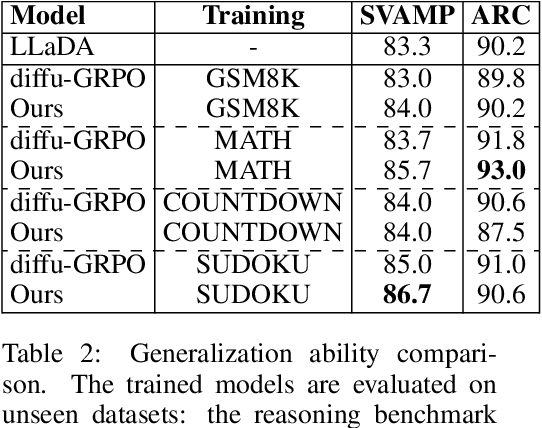
Abstract:Diffusion language models (dLLMs) offer a promising, non-autoregressive paradigm for text generation, yet training them for complex reasoning remains a key challenge. Current reinforcement learning approaches often rely on sparse, outcome-based rewards, which can reinforce flawed reasoning paths that lead to coincidentally correct answers. We argue that this stems from a fundamental mismatch with the natural structure of reasoning. We first propose a theoretical framework that formalizes complex problem solving as a hierarchical selection process, where an intractable global constraint is decomposed into a series of simpler, localized logical steps. This framework provides a principled foundation for algorithm design, including theoretical insights into the identifiability of this latent reasoning structure. Motivated by this theory, we identify unstructured refinement -- a failure mode where a model's iterative steps do not contribute meaningfully to the solution -- as a core deficiency in existing methods. We then introduce Step-Aware Policy Optimization (SAPO), a novel RL algorithm that aligns the dLLM's denoising process with the latent reasoning hierarchy. By using a process-based reward function that encourages incremental progress, SAPO guides the model to learn structured, coherent reasoning paths. Our empirical results show that this principled approach significantly improves performance on challenging reasoning benchmarks and enhances the interpretability of the generation process.
SmartCLIP: Modular Vision-language Alignment with Identification Guarantees
Jul 29, 2025Abstract:Contrastive Language-Image Pre-training (CLIP)~\citep{radford2021learning} has emerged as a pivotal model in computer vision and multimodal learning, achieving state-of-the-art performance at aligning visual and textual representations through contrastive learning. However, CLIP struggles with potential information misalignment in many image-text datasets and suffers from entangled representation. On the one hand, short captions for a single image in datasets like MSCOCO may describe disjoint regions in the image, leaving the model uncertain about which visual features to retain or disregard. On the other hand, directly aligning long captions with images can lead to the retention of entangled details, preventing the model from learning disentangled, atomic concepts -- ultimately limiting its generalization on certain downstream tasks involving short prompts. In this paper, we establish theoretical conditions that enable flexible alignment between textual and visual representations across varying levels of granularity. Specifically, our framework ensures that a model can not only \emph{preserve} cross-modal semantic information in its entirety but also \emph{disentangle} visual representations to capture fine-grained textual concepts. Building on this foundation, we introduce \ours, a novel approach that identifies and aligns the most relevant visual and textual representations in a modular manner. Superior performance across various tasks demonstrates its capability to handle information misalignment and supports our identification theory. The code is available at https://github.com/Mid-Push/SmartCLIP.
Position: Mechanistic Interpretability Should Prioritize Feature Consistency in SAEs
May 26, 2025Abstract:Sparse Autoencoders (SAEs) are a prominent tool in mechanistic interpretability (MI) for decomposing neural network activations into interpretable features. However, the aspiration to identify a canonical set of features is challenged by the observed inconsistency of learned SAE features across different training runs, undermining the reliability and efficiency of MI research. This position paper argues that mechanistic interpretability should prioritize feature consistency in SAEs -- the reliable convergence to equivalent feature sets across independent runs. We propose using the Pairwise Dictionary Mean Correlation Coefficient (PW-MCC) as a practical metric to operationalize consistency and demonstrate that high levels are achievable (0.80 for TopK SAEs on LLM activations) with appropriate architectural choices. Our contributions include detailing the benefits of prioritizing consistency; providing theoretical grounding and synthetic validation using a model organism, which verifies PW-MCC as a reliable proxy for ground-truth recovery; and extending these findings to real-world LLM data, where high feature consistency strongly correlates with the semantic similarity of learned feature explanations. We call for a community-wide shift towards systematically measuring feature consistency to foster robust cumulative progress in MI.
Towards Understanding Extrapolation: a Causal Lens
Jan 15, 2025



Abstract:Canonical work handling distribution shifts typically necessitates an entire target distribution that lands inside the training distribution. However, practical scenarios often involve only a handful of target samples, potentially lying outside the training support, which requires the capability of extrapolation. In this work, we aim to provide a theoretical understanding of when extrapolation is possible and offer principled methods to achieve it without requiring an on-support target distribution. To this end, we formulate the extrapolation problem with a latent-variable model that embodies the minimal change principle in causal mechanisms. Under this formulation, we cast the extrapolation problem into a latent-variable identification problem. We provide realistic conditions on shift properties and the estimation objectives that lead to identification even when only one off-support target sample is available, tackling the most challenging scenarios. Our theory reveals the intricate interplay between the underlying manifold's smoothness and the shift properties. We showcase how our theoretical results inform the design of practical adaptation algorithms. Through experiments on both synthetic and real-world data, we validate our theoretical findings and their practical implications.
Causal Representation Learning from Multimodal Biological Observations
Nov 10, 2024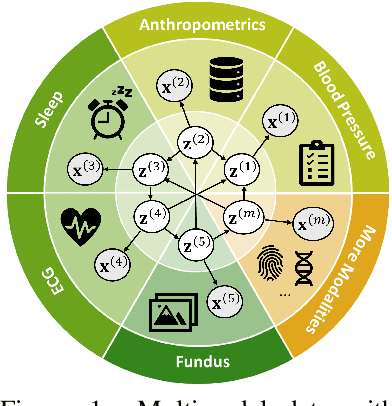

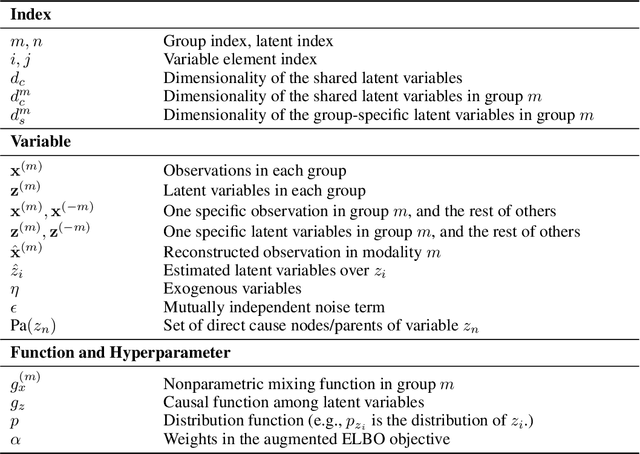
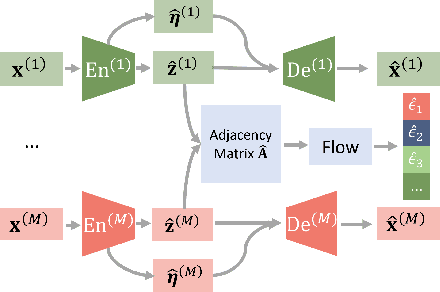
Abstract:Prevalent in biological applications (e.g., human phenotype measurements), multimodal datasets can provide valuable insights into the underlying biological mechanisms. However, current machine learning models designed to analyze such datasets still lack interpretability and theoretical guarantees, which are essential to biological applications. Recent advances in causal representation learning have shown promise in uncovering the interpretable latent causal variables with formal theoretical certificates. Unfortunately, existing works for multimodal distributions either rely on restrictive parametric assumptions or provide rather coarse identification results, limiting their applicability to biological research which favors a detailed understanding of the mechanisms. In this work, we aim to develop flexible identification conditions for multimodal data and principled methods to facilitate the understanding of biological datasets. Theoretically, we consider a flexible nonparametric latent distribution (c.f., parametric assumptions in prior work) permitting causal relationships across potentially different modalities. We establish identifiability guarantees for each latent component, extending the subspace identification results from prior work. Our key theoretical ingredient is the structural sparsity of the causal connections among distinct modalities, which, as we will discuss, is natural for a large collection of biological systems. Empirically, we propose a practical framework to instantiate our theoretical insights. We demonstrate the effectiveness of our approach through extensive experiments on both numerical and synthetic datasets. Results on a real-world human phenotype dataset are consistent with established medical research, validating our theoretical and methodological framework.
Adjusting Pretrained Backbones for Performativity
Oct 06, 2024



Abstract:With the widespread deployment of deep learning models, they influence their environment in various ways. The induced distribution shifts can lead to unexpected performance degradation in deployed models. Existing methods to anticipate performativity typically incorporate information about the deployed model into the feature vector when predicting future outcomes. While enjoying appealing theoretical properties, modifying the input dimension of the prediction task is often not practical. To address this, we propose a novel technique to adjust pretrained backbones for performativity in a modular way, achieving better sample efficiency and enabling the reuse of existing deep learning assets. Focusing on performative label shift, the key idea is to train a shallow adapter module to perform a Bayes-optimal label shift correction to the backbone's logits given a sufficient statistic of the model to be deployed. As such, our framework decouples the construction of input-specific feature embeddings from the mechanism governing performativity. Motivated by dynamic benchmarking as a use-case, we evaluate our approach under adversarial sampling, for vision and language tasks. We show how it leads to smaller loss along the retraining trajectory and enables us to effectively select among candidate models to anticipate performance degradations. More broadly, our work provides a first baseline for addressing performativity in deep learning.
Learning Discrete Concepts in Latent Hierarchical Models
Jun 01, 2024



Abstract:Learning concepts from natural high-dimensional data (e.g., images) holds potential in building human-aligned and interpretable machine learning models. Despite its encouraging prospect, formalization and theoretical insights into this crucial task are still lacking. In this work, we formalize concepts as discrete latent causal variables that are related via a hierarchical causal model that encodes different abstraction levels of concepts embedded in high-dimensional data (e.g., a dog breed and its eye shapes in natural images). We formulate conditions to facilitate the identification of the proposed causal model, which reveals when learning such concepts from unsupervised data is possible. Our conditions permit complex causal hierarchical structures beyond latent trees and multi-level directed acyclic graphs in prior work and can handle high-dimensional, continuous observed variables, which is well-suited for unstructured data modalities such as images. We substantiate our theoretical claims with synthetic data experiments. Further, we discuss our theory's implications for understanding the underlying mechanisms of latent diffusion models and provide corresponding empirical evidence for our theoretical insights.
Counterfactual Generation with Identifiability Guarantees
Feb 23, 2024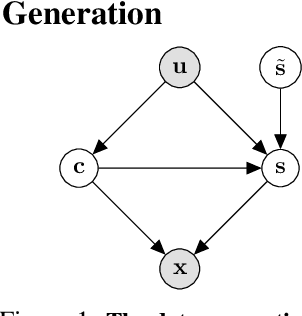
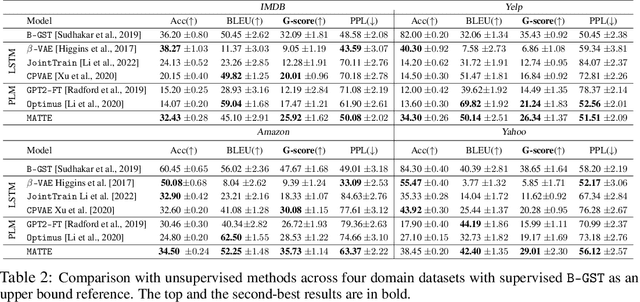
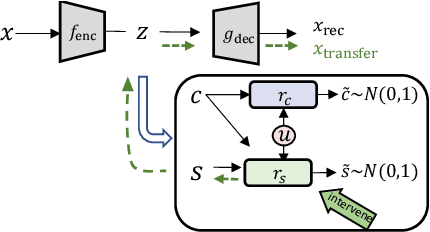
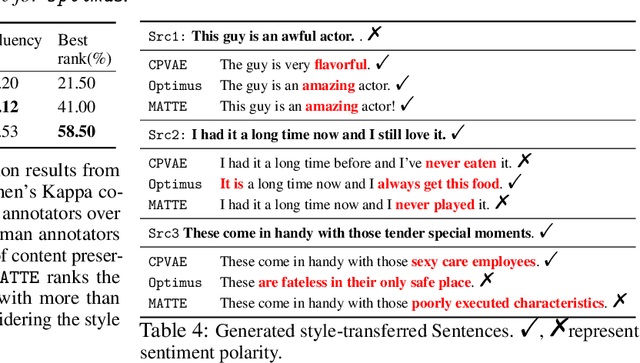
Abstract:Counterfactual generation lies at the core of various machine learning tasks, including image translation and controllable text generation. This generation process usually requires the identification of the disentangled latent representations, such as content and style, that underlie the observed data. However, it becomes more challenging when faced with a scarcity of paired data and labeling information. Existing disentangled methods crucially rely on oversimplified assumptions, such as assuming independent content and style variables, to identify the latent variables, even though such assumptions may not hold for complex data distributions. For instance, food reviews tend to involve words like tasty, whereas movie reviews commonly contain words such as thrilling for the same positive sentiment. This problem is exacerbated when data are sampled from multiple domains since the dependence between content and style may vary significantly over domains. In this work, we tackle the domain-varying dependence between the content and the style variables inherent in the counterfactual generation task. We provide identification guarantees for such latent-variable models by leveraging the relative sparsity of the influences from different latent variables. Our theoretical insights enable the development of a doMain AdapTive counTerfactual gEneration model, called (MATTE). Our theoretically grounded framework achieves state-of-the-art performance in unsupervised style transfer tasks, where neither paired data nor style labels are utilized, across four large-scale datasets. Code is available at https://github.com/hanqi-qi/Matte.git
Identification of Nonlinear Latent Hierarchical Models
Jun 13, 2023Abstract:Identifying latent variables and causal structures from observational data is essential to many real-world applications involving biological data, medical data, and unstructured data such as images and languages. However, this task can be highly challenging, especially when observed variables are generated by causally related latent variables and the relationships are nonlinear. In this work, we investigate the identification problem for nonlinear latent hierarchical causal models in which observed variables are generated by a set of causally related latent variables, and some latent variables may not have observed children. We show that the identifiability of both causal structure and latent variables can be achieved under mild assumptions: on causal structures, we allow for the existence of multiple paths between any pair of variables in the graph, which relaxes latent tree assumptions in prior work; on structural functions, we do not make parametric assumptions, thus permitting general nonlinearity and multi-dimensional continuous variables. Specifically, we first develop a basic identification criterion in the form of novel identifiability guarantees for an elementary latent variable model. Leveraging this criterion, we show that both causal structures and latent variables of the hierarchical model can be identified asymptotically by explicitly constructing an estimation procedure. To the best of our knowledge, our work is the first to establish identifiability guarantees for both causal structures and latent variables in nonlinear latent hierarchical models.
Partial Identifiability for Domain Adaptation
Jun 10, 2023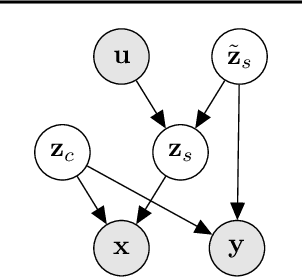

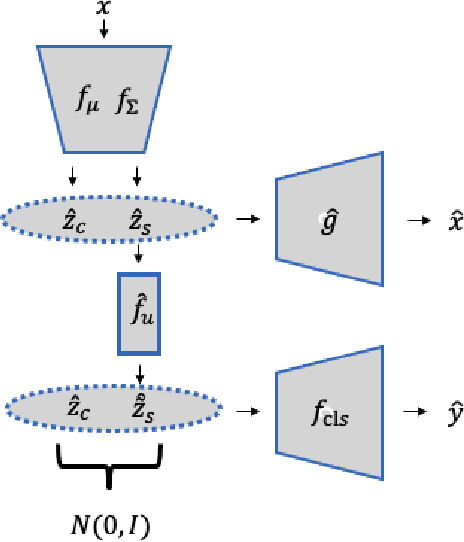

Abstract:Unsupervised domain adaptation is critical to many real-world applications where label information is unavailable in the target domain. In general, without further assumptions, the joint distribution of the features and the label is not identifiable in the target domain. To address this issue, we rely on the property of minimal changes of causal mechanisms across domains to minimize unnecessary influences of distribution shifts. To encode this property, we first formulate the data-generating process using a latent variable model with two partitioned latent subspaces: invariant components whose distributions stay the same across domains and sparse changing components that vary across domains. We further constrain the domain shift to have a restrictive influence on the changing components. Under mild conditions, we show that the latent variables are partially identifiable, from which it follows that the joint distribution of data and labels in the target domain is also identifiable. Given the theoretical insights, we propose a practical domain adaptation framework called iMSDA. Extensive experimental results reveal that iMSDA outperforms state-of-the-art domain adaptation algorithms on benchmark datasets, demonstrating the effectiveness of our framework.
 Add to Chrome
Add to Chrome Add to Firefox
Add to Firefox Add to Edge
Add to Edge